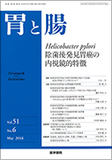Japanese
English
- 有料閲覧
- Abstract 文献概要
- 1ページ目 Look Inside
- 参考文献 Reference
- サイト内被引用 Cited by
要旨●早期胃癌に対する粘膜下層剝離術(ESD)後の異時性多発胃癌リスクは,除菌により軽減するものの,0にはならず5年間の累積発生率は15%にも及ぶ.しかし,サーベイランスの方法を個別化するためのリスク評価方法はいまだ確立していない.横断研究により胃癌で認められるDNAメチル化異常は非癌部粘膜にも認め,その程度(メチル化レベル)は胃癌発生リスクと相関した.昨年,ESD後異時性多発胃癌において,メチル化レベルの発癌リスクマーカーとしての有用性が多施設前向き研究により示された.現在,H. pylori除菌後患者を対象とした多施設前向き研究が開始され,メチル化レベルによるリスク層別の実用化をめざしている.
Metachronous gastric cancer risk following ESD(endoscopic submucosal dissection)for early gastric cancer is reduced via Helicobacter pylori(H. pylori)eradication ; however, the 5-year cumulative incidence of metachronous gastric cancer remains as high as 15%. Nevertheless, a risk assessment for individualizing surveillance method has not yet been established. DNA methylation observed in gastric cancer in a cross-sectional study has additionally been found in non-cancerous mucosa, and its degree(methylation level)was found to be correlated with gastric cancer risk. Last year, the usefulness of the methylation level as a marker of metachronous cancer risk was shown in a multicenter prospective study in post-ESD gastric cancer patients. Currently, another multicenter prospective study in patients following H. pylori eradication has been started, and is aimed at the practical use of methylation level as a marker for gastric cancer risk assessment.

Copyright © 2016, Igaku-Shoin Ltd. All rights reserved.


